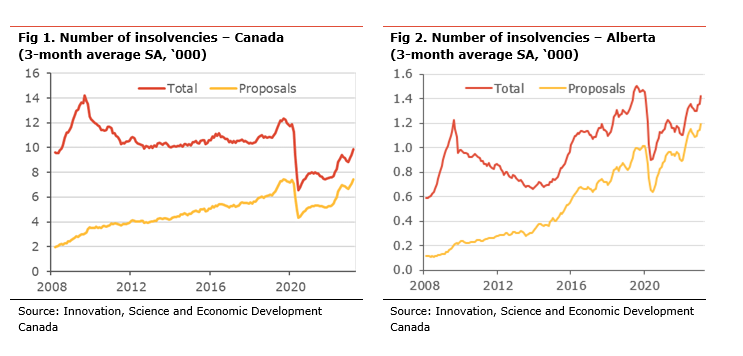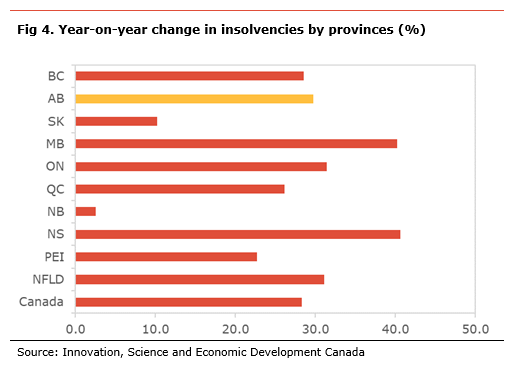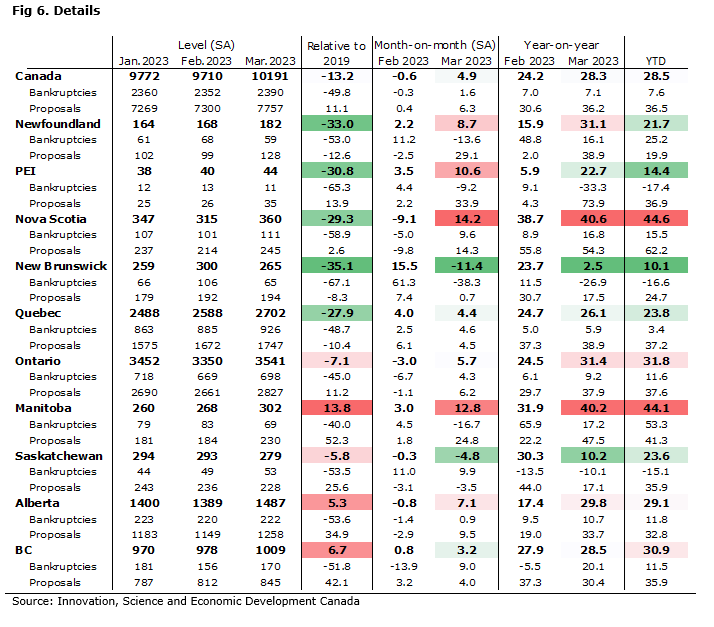Economic insight provided by Alberta Central Chief Economist Charles St-Arnaud.
Bottom line
Insolvencies rose sharply in March on a seasonally-adjusted basis. This follows a moderation in February and a period of weakness in insolvencies since the end of the summer despite continued strains on households’ finances due to a sharp rise in interest rates and continued deterioration in households’ purchasing power over the period.
With the surge in March, insolvencies are currently at their highest level since the start of the pandemic. As such, proposals (a renegotiation of terms) are now above their pre-pandemic level at the national level and in most provinces. We also note that the total level of insolvencies in Manitoba, BC and Alberta is above its pre-pandemic one; a situation that suggests a rise in households struggling with their debt load.
March is usually a strong month for insolvencies, but this increase in 2023 has been more significant than usual in all provinces, with many of the monthly increases being more than double normal patterns (see fig. 5). It is not clear whether insolvencies are catching up after some weakness in late 2022 or whether this is a new trend of accelerated increase in insolvencies.
Record levels of household debt, declining purchasing power due to rising inflation, and the sharp rise in interest rates are putting pressure on households’ finances (see The Great Consumer Squeeze for details). Interestingly, there seems to be little correlation between the change in purchasing power since 2019 and insolvencies by provinces (see The Alberta Advantage is melting away). Moreover, a slowing economy is likely to be associated with a rise in unemployment. All those factors point to a rise in insolvencies in 2023. The question is whether the continued strength of the labour market, with the very low unemployment rate, and the vast amount of saving accumulated during the pandemic will continue to provide some relief.
In Alberta, the recovery in the oil sector, with the value of oil production reaching an all-time high since mid-2021 (production value has averaged $11bn in 2022), and the associated tailwind to the economy and a robust labour market could help to hold back insolvencies. However, Albertan households have some of the highest debt-to-income ratios, making them vulnerable to rising interest rates, and have seen a decline a biggest decline in their purchasing power than other provinces. In addition, we note that the level of insolvency and proposals (a renegotiation of terms) are well above its pre-pandemic one.
Insolvencies surged 4.9% m-o-m in March on a seasonally-adjusted basis, after easing in February, reaching their highest level since February 2020 or the start of the pandemic. Insolvencies, which include both bankruptcies and proposals (a renegotiation of terms), rose by 28.3% compared to the same month last year. This resulted from a 36.2% y-o-y rise in proposals and a 7.1% y-o-y increase in bankruptcies. Compared to last year, insolvencies increased in every province, with the most significant rises in Nova Scotia (+40.6% y-o-y), Manitoba (+40.2% y-o-y), Ontario (+31.4% y-o-y), and Newfoundland (+31.1% y-o-y). New Brunswick (+23.7% y-o-y), Saskatchewan (+10.2% m-o-m), PEI (+22.7% y-o-y), and Quebec (26.1% y-o-y) saw the smallest, yet still large in most cases, increases.
On a monthly basis, insolvencies rose by 4.9% m-o-m seasonally-adjusted (sa) in March. The details show that both proposals (+6.3% m-o-m sa) and bankruptcies (+1.6% m-o-m sa) rose on the month. At the provincial level, Nova Scotia (+14.2% m-o-m sa), Manitoba (+12.8% m-o-m sa), PEI (+10.6% m-o-m sa), and Newfoundland (+8.7% m-o-m sa) saw the biggest increase in insolvencies, while they declined in New Brunswick (-11.4% m-o-m sa) and Saskatchewan (-4.8% m-o-m sa).
Relative to 2019, insolvencies in Canada are still 13% lower. However, we note that the level of insolvencies is higher compared to pre-COVID in Manitoba (+13.8%), BC (+6.7%), and Alberta (+5.3%) The level of insolvencies is still well below pre-pandemic in New Brunswick (-35.1%), Newfoundland (-33.0%), PEI (-30.8%), Nova Scotia (-29.3%), and Quebec (-27.9%)
We note that the level of proposals in Canada is above its pre-pandemic level (+11%). The level of proposals is above its pre-COVID level in most provinces led by Manitoba (+52%), BC (+42%), Alberta (+35%), Saskatchewan (+27%), PEI (+14%) and Ontario (+11%). This suggests that an increasing share of households are facing financial stress.
In Alberta, insolvencies rose by 7.1% m-o-m sa and by 29.8% compared to the same month last year. Over the past 12 months, there have been 16.1k insolvencies, the highest since May 2020, but still well below their pre-pandemic levels of 17.2k. On a seasonally-adjusted basis, the increase in insolvencies in March came from both proposals (+9.5% m-o-m sa) and bankruptcies (+0.9% m-o-m sa.). We note that the level of proposals is currently about 35% above its pre-pandemic level, while bankruptcies are 54% below pre-COVID.





Independent Opinion
The views and opinions expressed in this publication are solely and independently those of the author and do not necessarily reflect the views and opinions of any organization or person in any way affiliated with the author including, without limitation, any current or past employers of the author. While reasonable effort was taken to ensure the information and analysis in this publication is accurate, it has been prepared solely for general informational purposes. There are no warranties or representations being provided with respect to the accuracy and completeness of the content in this publication. Nothing in this publication should be construed as providing professional advice on the matters discussed. The author does not assume any liability arising from any form of reliance on this publication.